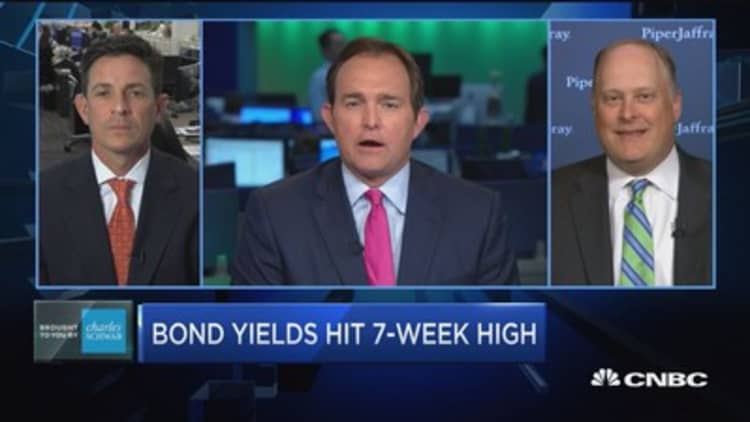
Like Fed officials on interest rates, strategists are divided when it comes to the bond market's direction.
The 10-year Treasury note yield hit a seven-week high of 2.357 percent on Wednesday ahead of the release of the minutes from the Federal Reserve's June meeting. It finished the day slightly lower at 2.32 percent.
The note's yield is considered a key measure of the economy's health. Even as the central bank has raised its federal funds target rate and stocks have hit new highs, the 10-year yield has traded in a narrow range for much of this year.
"I wouldn't be surprised to see a flattening in the [yield] curve in the short- and intermediate-term," Washington Crossing Advisors portfolio manager Chad Morganlander said by email Wednesday.
Investors should focus on global central banks' communication when it comes to the bond market's direction, Morganlander said. He added that with the Fed in the midst of tightening monetary policy, financial conditions will begin to tighten and volatility will increase.
When it comes to the European Central Bank and its messaging, Morganlander believes that although the recent signal has been "less accommodative," negative interest rates will continue as an anchor to long-term rates and will ultimately keep the "long end" of the yield curve — longer-dated bond yields — down.
European Central Bank President Mario Draghi's comments last week on the state of monetary policy were taken as hawkish, sending rates rising around the euro zone — the German bund's yield logged its largest weekly jump since December 2015, for example. That triggered a sell-off in the 10-year Treasury note. Bank of England Governor Mark Carney, too, said last week that the British central bank would likely consider a rate increase in the coming months.
"We think that inflation expectations will be stubbornly low over the course of the next 18 months. I wouldn't be surprised to see last week's sell-off, where interest rates on the 10-year went to [2.3 percent], actually reverse itself," Morganlander said Wednesday on CNBC's "Power Lunch."
From a technical perspective, however, yields actually appear to be heading higher and will likely achieve his year-end target range of 3 to 3.25 percent, said Piper Jaffray chief market technician Craig Johnson.
"You can see the big downtrend reversal happened after the Trump victory. You then went higher, got stuck in a range of [2.30 to 2.60 percent], then you pull it back. This was just a normal pullback to retest. Now I think we're moving higher; we're up [2.33 to 2.34 percent] here," Johnson, observing a five-year chart of the 10-year Treasury note yield, said Wednesday on "Power Lunch."
"I suspect when you start moving up toward [2.60 percent] and even higher, I think you're going to start to see the reflation trade kick back in," he said, adding that he believes rates will at long last push up toward 3 percent, a level it has not touched since the first week of trading in 2014.
Johnson said: "I feel even stronger about our year-end call of 3, 3.25 [percent] in the 10-year bond yield at this point."






